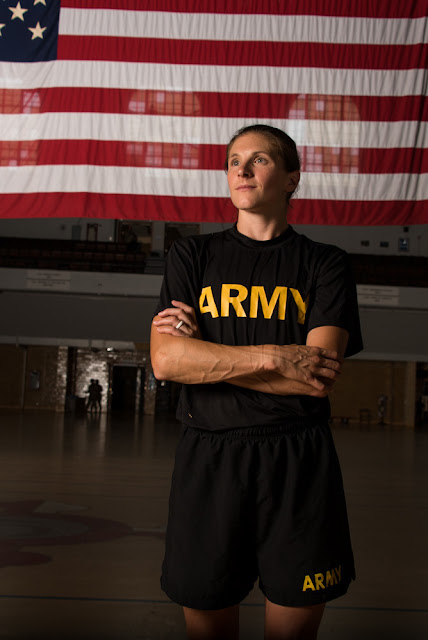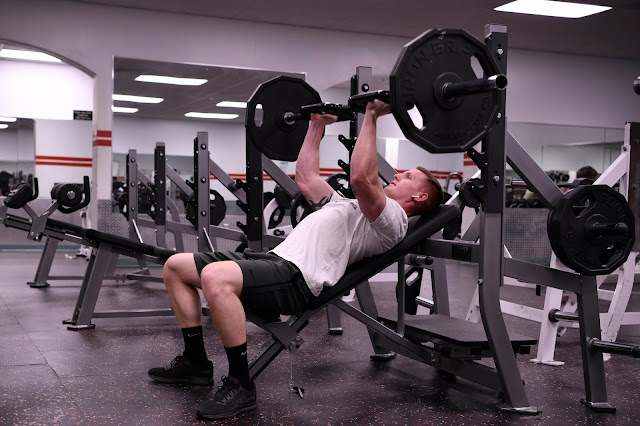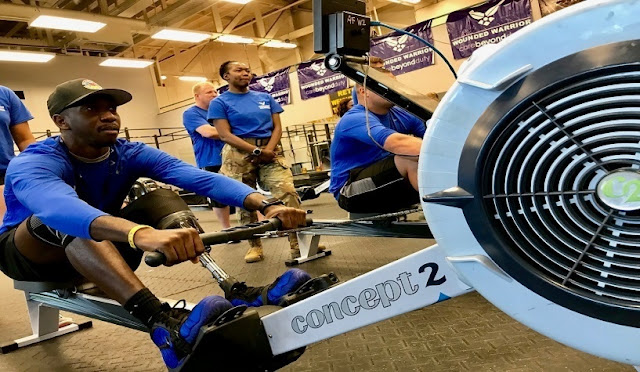Innovation Fitness - MDNG Soldiers Push Their Limits
Story by Senior Airman Sarah McClanahan
Maryland National Guard Public Affairs Office
Some soldiers physically push themselves, compete against who they were yesterday, and train above and beyond meeting the minimum requirements of an Army physical fitness test. As motivation to be physically active can vary, some Maryland Army National Guard soldiers conduct their regular exercise routines in innovative ways.
Soldiers like Capt. Meghan Landymore, an ultra marathoner and member of the All Guard Marathon Team; Sgt. Donita Adams, a basketball coach and All-Army Women’s Basketball team member; and Capt. Ben Smith, an avid obstacle course racer and American Ninja Warrior participant, are passionately competing in high levels of sports and maintaining their personal fitness.
Soldiers are required to maintain a certain standard of physical fitness. The annual Army Physical Fitness Test requirement for soldiers gives commanders an indication of the overall fitness of the soldier. The Army is now transitioning to the Army Combat Fitness Test, a six-event, age and gender neutral test, designed to assess a soldier’s physical fitness and readiness for physically demanding combat situations. Staying active can help prepare individuals to maintain a level of fitness for the physical demands of military service.
Runner for Life
Capt. Meghan Landymore, a Joint Force Headquarters Medical Detachment physician assistant, is an accomplished ultra-marathon runner and member of the All Guard Marathon team. Each year, Army and Air guardsmen compete for a position on the All Guard Marathon Team during the National Guard Marathon Trials. The trials take place during the Lincoln Marathon, a traditional 26.2 mile marathon race, in Lincoln, Nebraska. Landymore placed third in her age group, sixth overall, and qualified for the national team with a time of 3:23:09.
Landymore first moved off the starting block as a competitive runner in high school, where she was required to participate in a sport. As a kid who grew up performing gymnastics, running wasn’t her initial choice. However, after some encouragement from her father, she found her path — cross country.
On her first day of practice where every single person raised their hand in response to the question “who trained over the summer?” Every person except for her. The feeling of being behind the curve wasn’t something she was comfortable with. But, after working hard with her new coach, Landymore quickly became one of the top athletes on the team after just a couple short months.
Once she started, no one could stop her stride. Landymore ran all throughout her years in college and ran her first marathon, the 2010 New York City Marathon, while in graduate school. In 2012, she placed ninth overall for her first ultra-marathon, the Golden Gate Trail Run Winter 50K, with a time of 5:02:34. Ultra-marathons are anything over the traditional 26.2 mile marathon and sometimes through challenging trails that require hiking or climbing. With more than 30 ultra-marathons under her belt, this July she competed in the 106-mile North Dakota Maah Daah Hey Trail Run with the All Guard Marathon Team.
For ultra-marathon athletes like Landymore, training for a race becomes more than just a form of physical fitness, it becomes a lifestyle.
“It affects everything,” said Landymore. “It becomes your personality and becomes what you talk about, and who you hang out with.”
Training includes a combination of all types of running, from lengthy distances, overnight trail runs, tempo runs on a track, to hitting a strength training session in the weight room. However, training extends beyond the track or gym, needing to balance nutrition and family life can be a challenging task.
“It takes a lot to try and eat enough calories that are not junk calories,” says Landymore. “Other than nutrition, you’re fatigued. Just getting through daily life is actually really hard as an ultra runner. I think we overlook it because it’s just what we do. It’s exhausting, I have two young kids. It affects my husband. Though they are supportive and understanding as much as they can be.”
On race day, her family often plays an impactful role of supporting her through the experience. Her husband will sometimes pace her for portions of her runs or act as a support crew providing various supplies like dry shoes or socks at each stop throughout the race. Her 4-year old son even ran with her through the finish line during the 2017 Patapsco Valley 50K.
Landymore explains that the supportive community of ultra-marathoning is what the experience is all about. Ultra-marathon racing is more than simply running, it gives other invaluable attributes.
“I think a big part of people [competing in any sport] is being able to be in pain and to handle it for any given time whether that’s a few seconds or few minutes,” says Landymore. “You have to know how to be uncomfortable. I think that’s necessary for most of life.”
Nothing but Net
Sgt. Donita Adams, a MDNG chaplain’s assistant and All-Army Women’s Basketball team member, connects her faith and the love she has for the game of basketball. She is the only National Guard member selected for an all-star team to compete at the 2016 Conseil-International-Du-Sport-Militaire World Military Women's Basketball Championship.
“Basketball is a way that I can cope with a lot of things,” says Adams. “If I’m stressed out, I know I can go play basketball and clear my mind from anything. It’s my peace. God has given me a way to escape and go into an element where him and I can connect. Basketball is almost like that connection that I have with God. It ties us together because it’s something that I’m passionate about.”
Both basketball and her faith have been pivotal elements in Adams’ life. At 5-years old she picked up a basketball for the first time and by 8-years old started playing on a team. It wasn’t until highschool that Adams found her love for coaching.
At 16, Adams landed her first coaching gig at a summer camp. Unbeknownst to her, one of the girls she would coach that summer was the daughter of an inspiring teacher Adams had in the sixth grade. This teacher saw the potential in Adams and made a point to push her to succeed. It was at this camp that her passion for mentorship and coaching ignited.
“My Amateur Athletic Union coach was a big influence in my life, a father that I didn’t have,” said Adams. “I knew that I wanted to give back to my community and this [coaching] was my way to give back.”
Prior to enlisting in the Army, Adams took on a head coaching job at Watkins Mill High School, the school she attended prior to transferring to Damascus High School. For four years, she taught and developed nearly 100 female student athletes on and off the basketball court. She taught the importance of mentorship and being a role model as an athlete.
“Sometimes you don’t sign up for this stuff,” said Adams. “But when you put on that jersey, or when you sign up for a sport, it comes along with it.”
Adams recently resigned from her head coaching position to give herself the opportunity to impact young athletes beyond the walls of Watkins Mill High School. Now she coaches the young men and women of Truth Basketball, a personal venture dedicated to teaching, coaching, and mentoring young athletes. Truth Basketball holds fundraisers to cover much of the fees associated with playing basketball. Adams hopes to turn the venture into a non-profit in the future to continue making basketball accessible and providing more resources to young men and women.
In addition to coaching, Adams is in her third year of playing for the All-Army Women’s Basketball team. This October, she’s headed to Wuhan, China to play with Team USA in the Military World Cup Games. For the second time, Adams will have the opportunity to play with Team USA representing the Maryland Army National Guard on an international stage. However, this will be the first time she will play in an olympic-level event.
Leaping Over Obstacles
Capt. Ben Smith, 32nd Civil Support Team survey team leader, an avid obstacle course runner and a participant in the 2019 Baltimore Maryland City Qualifiers for American Ninja Warrior, a show where contestants demonstrate their agility and strength through challenging obstacle courses.
Through his training for the Toughest Mudder races, an overnight, eight-hour version of the Tough Mudder races, Smith realized while he was adequately conditioned to run the course, his technique work in tackling obstacles needed to be strengthened. This is where Smith was introduced to the world of American Ninja Warrior.
“I began Ninja Warrior training to increase obstacle course proficiency,” said Smith. “From there, I fell in love with the sport.”
Each year, ANW hosts city qualifying and final competitions in different cities throughout the nation including Baltimore. Each qualifier race consists of six obstacles testing competitors’ ninja skills including grip strength, lateral transversing, static or dynamic balance, and explosive movement. Competitors will need to efficiently and cohesively use all of these skills to complete an ANW course.
“The principles are the same as the preparation for any school, task, or mission,” explains Smith. “I worked through minor obstacles and adjusted my plan for major ones. The first key was to assess the skills I would need to develop. This is a challenge as no two ninja courses are the same. I set out a plan to identify weaknesses and train them in lieu of improving only my strengths.”
To be selected, Smith competed for one of around 600 slots against about 60,000 applicants. The selection decision rested entirely on his submission video. Once he was selected, his ANW training began.
Smith explains simply being physically fit will not carry an athlete far in ANW and a more well-rounded approach to training is required. To prepare for his competition, Smith’s physical training and conditioning focused on improving endurance, speed work, functional strength, balance, and active recovery. This often resulted in late nights at his obstacle course gym multiple times a week. Smith would also incorporate ninja training into his regular physical training for the Army by including exercises focused on grip strength, balance, or running on curbsides for portions of his regular runs.
However, the biggest obstacle for Smith’s training was the unknown. The day prior to the competition he was able to see the course but wasn’t able to touch any of the obstacles prior to competing.
Though challenging, tackling the ANW course helped Smith identify areas he could improve upon including his speed and fluidity between the different obstacles. His training leading up to the race focused on individual skills. In practice, it was a struggle to apply them cohesively on the course.
Unfortunately, Smith did not successfully complete his run of the Baltimore Maryland City Qualifiers and was stopped short at the second obstacle of the race, the double twister. This obstacle involves two free-spinning pendulums where competitors must leap from a springboard to the first pendulum and use their momentum to move from each pendulum and finally to the landing platform. An unexpected stopper restricting the movement of the second pendulum caused Smith to ultimately plummet into the water.
While his run was not aired on this episode of ANW, a short clip of his entrance was aired of Smith ripping off of a modified level A vapor protection suit. Vapor protection suits are crucial for protection against dangerous chemicals encountered in Smith’s job with the 32nd Civil Support Team.
Despite recently sustaining a broken ankle, he is determined to work through his injury and get back to training and sharpening his ninja skills for the next round of applications.
The MDNG Athlete
For every Maryland National Guard soldier, “game day” may not come in the form of an ultra-marathon, basketball game, or obstacle course race. Instead, the training, conditioning, and physical readiness of each and every soldier is tested by the APFT or fast-approaching ACFT.
It’s important to note that the ACFT will not be an easy test and must be approached with a well-rounded training program personalized for each individual soldier to build them up from where they are starting to where they need to be, explained Landymore.
Competing at a higher level of sports is not the only option for soldiers preparing for the ACFT. A voluntary program called “Fit to Serve” is available to soldiers for coaching in fitness and offers technology to track physical activity and sleeping habits. The program also provides physical therapy resources which focus on overall health wellness and resiliency.
“The best advice I can give is to use the resources around you,” says Adams. “There are people in your circle or even in your unit who are experts, like trainers or athletes, so use those resources. They are very knowledgeable. Take time during your drill weekend to do the exercises and workouts because it’s going to help you. Because as soon as it’s implemented we are expected to perform.”




Comments
Post a Comment